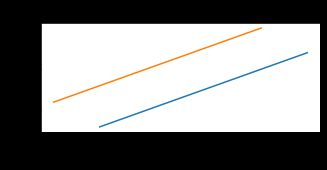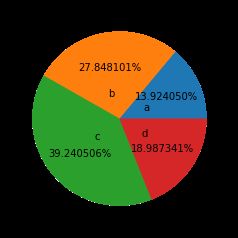3 Python数据分析 美国各州人口分析案例 Pandas高级操作 美国大选献金案例 matplotlib
Python数据分析
1 案例 美国各州人口分析
1.1 数据介绍
数据来源:https://github.com/jakevdp/data-USstates/
1.1.1 州人口数量表 state-population.csv
| 字段 | 字段名 | 备注 |
|---|---|---|
| state/region | 州/区域 | 州简称,与state-abbrevs.csv文件中的abbreviation字段对应 |
| ages | 人口年龄 | 选项包括18岁以下under18和全部年龄段total |
| year | 年份 | |
| population | 人口数量 |
1.1.2 州面积表 state-areas.csv
| 字段 | 字段名 | 备注 |
|---|---|---|
| state | 州名称 | 州全称,与state-abbrevs.csv文件中的state字段对应 |
| area (sq. mi) | 州面积 |
1.1.3 州简称对照表 state-abbrevs.csv
| 字段 | 字段名 | 备注 |
|---|---|---|
| state | 州全称 | |
| abbreviation | 州简称 |
1.2 需求
将人口数据与各州简称数据进行合并,对合并数据中重复的abbreviation列进行删除;
找到使state的值为NaN的state/region,补上合适的值;
找到并删除area(sq.mi)列中的缺失数据所在行;
获取2010年的全民人口数据;
计算各州的人口密度,排序并获取人口密度最高的州。
1.3 分析:州人口数据-州简称数据
1.3.1 导入数据
import numpy as np
import pandas as pd
from pandas import Series, DataFrame
# 州人口数量表
popu_df = pd.read_csv('./state-population.csv')
popu_df.head()
'''
state/region ages year population
0 AL under18 2012 1117489.0
1 AL total 2012 4817528.0
2 AL under18 2010 1130966.0
3 AL total 2010 4785570.0
4 AL under18 2011 1125763.0
'''
# 州面积表
area_df = pd.read_csv('./state-areas.csv')
area_df.head()
'''
state area (sq. mi)
0 Alabama 52423
1 Alaska 656425
2 Arizona 114006
3 Arkansas 53182
4 California 163707
'''
# 州简称对照表
abbr_df = pd.read_csv('./state-abbrevs.csv')
abbr_df.head()
'''
state abbreviation
0 Alabama AL
1 Alaska AK
2 Arizona AZ
3 Arkansas AR
4 California CA
'''
1.3.2 合并数据:州人口数据-州简称数据
将州人口数据与州简称数据进行合并,删除重复列。
# 合并
popu_abbr_df = pd.merge(left=popu_df, right=abbr_df, left_on='state/region', right_on='abbreviation', how='outer')
# 删除重复列abbreviation
popu_abbr_df.drop(labels='abbreviation', axis=1, inplace=True)
1.3.3 缺失值处理
判断是否存在缺失值
popu_abbr_df.info()
'''
Int64Index: 2544 entries, 0 to 2543
Data columns (total 5 columns):
# Column Non-Null Count Dtype
--- ------ -------------- -----
0 state 2448 non-null object
1 state/region 2544 non-null object
2 ages 2544 non-null object
3 year 2544 non-null int64
4 population 2524 non-null float64
dtypes: float64(1), int64(1), object(3)
memory usage: 119.2+ KB
'''
可以看出,数据一共有2544条,但state列和population列数据量小于2544条,因此这两列中存在缺失数据。
popu_abbr_df.isnull().any(axis=0)
'''
state True
state/region False
ages False
year False
population True
dtype: bool
'''
观察缺失值
nan_df = popu_abbr_df.loc[popu_abbr_df.isnull().any(axis=1)]
nan_df.head()
'''
state state/region ages year population
2448 NaN PR under18 1990 NaN
2449 NaN PR total 1990 NaN
2450 NaN PR total 1991 NaN
2451 NaN PR under18 1991 NaN
2452 NaN PR total 1993 NaN
'''
nan_df['state/region'].unique()
# array(['PR', 'USA'], dtype=object)
说明简称PR和USA没有对应的全称。
pr_indexs = popu_abbr_df.loc[popu_abbr_df['state/region'] == 'PR'].index
popu_abbr_df.loc[pr_indexs, 'state'] = 'Puerto Rico'
usa_indexs = popu_abbr_df.loc[popu_abbr_df['state/region'] == 'USA'].index
popu_abbr_df.loc[usa_indexs, 'state'] = 'United State'
删除population列的缺失数据所在行
nan_indexs = popu_abbr_df.loc[popu_abbr_df['population'].isnull()].index
popu_abbr_df.drop(labels=nan_indexs, axis=0, inplace=True)
popu_abbr_df.info()
'''
popu_abbr_df.info()
Int64Index: 2524 entries, 0 to 2543
Data columns (total 5 columns):
# Column Non-Null Count Dtype
--- ------ -------------- -----
0 state 2524 non-null object
1 state/region 2524 non-null object
2 ages 2524 non-null object
3 year 2524 non-null int64
4 population 2524 non-null float64
dtypes: float64(1), int64(1), object(3)
memory usage: 118.3+ KB
'''
1.3.4 ages列分析
ages列中的数据选项
popu_abbr_df['ages'].unique()
# array(['under18', 'total'], dtype=object)
查看ages列中不同选项出现的次数
popu_abbr_df['ages'].value_counts()
'''
total 1262
under18 1262
Name: ages, dtype: int64
'''
1.4 分析:州人口数据-州面积数据
1.4.1 合并数据:州人口数据-州面积数据
popu_area_df = pd.merge(left=popu_abbr_df, right=area_df, on='state', how='outer')
popu_area_df.info()
'''
Int64Index: 2524 entries, 0 to 2523
Data columns (total 6 columns):
# Column Non-Null Count Dtype
--- ------ -------------- -----
0 state 2524 non-null object
1 state/region 2524 non-null object
2 ages 2524 non-null object
3 year 2524 non-null int64
4 population 2524 non-null float64
5 area (sq. mi) 2476 non-null float64
dtypes: float64(2), int64(1), object(3)
memory usage: 138.0+ KB
'''
1.4.2 缺失值处理
nan_indexs = popu_area_df.loc[popu_area_df['area (sq. mi)'].isnull()].index
popu_area_df.drop(labels=nan_indexs, axis=0, inplace=True)
popu_area_df.info()
'''
Int64Index: 2476 entries, 0 to 2475
Data columns (total 6 columns):
# Column Non-Null Count Dtype
--- ------ -------------- -----
0 state 2476 non-null object
1 state/region 2476 non-null object
2 ages 2476 non-null object
3 year 2476 non-null int64
4 population 2476 non-null float64
5 area (sq. mi) 2476 non-null float64
dtypes: float64(2), int64(1), object(3)
memory usage: 135.4+ KB
'''
1.4.3 找出2010年的全民人口数据
条件查询
popu_area_df.query('year == 2010 & ages == "total"')
1.4.4 人口密度排序
计算人口密度
popu_area_df['population density'] = popu_area_df['population'] / popu_area_df['area (sq. mi)']
人口密度排序(降序)
popu_area_df.sort_values(by='population density', axis=0, ascending=False)
2 Pandas高级操作
2.1 替换操作 replace
df.replace(to_replace=原值, value=替换值)
替换操作可以作用于Series和DataFrame中。
2.1.1 单值替换
import numpy as np
import pandas as pd
from pandas import DataFrame
df = DataFrame(data=np.random.randint(0, 10, size=(3, 6)))
'''
0 1 2 3 4 5
0 2 4 8 9 8 0
1 6 1 3 8 0 2
2 3 6 7 9 8 4
'''
普通替换:替换所有符合要求的元素。
re_df1 = df.replace(to_replace=0, value='zero')
'''
0 1 2 3 4 5
0 2 4 8 9 8 zero
1 6 1 3 8 zero 2
2 3 6 7 9 8 4
'''
2.1.2 多值替换
re_df2 = df.replace(to_replace={
6:'six', 2:'two'})
'''
0 1 2 3 4 5
0 two 4 8 9 8 0
1 six 1 3 8 0 two
2 3 six 7 9 8 4
'''
2.1.3 定列替换
将第3列的数字9替换为字符串nine。
re_df3 = df.replace(to_replace={
3: 9}, value='nine')
'''
0 1 2 3 4 5
0 2 4 8 nine 8 0
1 6 1 3 8 0 2
2 3 6 7 nine 8 4
'''
2.2 映射操作 map
映射:根据映射关系表,把一个元素和一个特定的标签或字符串绑定在一起,可以为元素提供不同的表现形式。
map方法是调用者的数据作为参数依次传入到映射字典或函数中,得到映射后的值。
map方法是Series的方法,只能被Series对象调用。
name_salary_dict = {
'name': ['Jay', 'Tom', 'Jay'],
'salary': [1000, 2000, 1000]
}
name_salary_df = DataFrame(data=name_salary_dict)
'''
name salary
0 Jay 1000
1 Tom 2000
2 Jay 1000
'''
映射关系列表
mapping_dict = {
'Jay': '杰',
'Tom': '汤姆'
}
name_salary_df['name_chs'] = name_salary_df['name'].map(mapping_dict)
'''
name salary name_chs
0 Jay 1000 杰
1 Tom 2000 汤姆
2 Jay 1000 杰
'''
2.3 运算操作 map,apply
参考上表中的数据,工资超过1000的部分需要扣除50%的费用,计算每个人的薪资。
def calc_salary(salary):
if salary >= 1000:
salary = (salary - 1000) * 0.5
return salary
2.3.1 map
map方法将函数作用于调用者Series对象中的每个元素。
map方法只能被Series对象调用,只能传入一个参数。
name_salary_df['salary_real'] = name_salary_df['salary'].map(calc_salary)
2.3.2 apply
- Series
apply支持传入多个参数。
工资超过基数base的部分需要扣除50%的费用,计算每个人的薪资。
def calc_salary(salary, base):
if salary >= base:
salary = (salary - base) * 0.5
return salary
name_salary_df['salary_real'] = name_salary_df['salary'].apply(calc_salary, args=(500,))
'''
name salary name_chs salary_real
0 Jay 1000 杰 250.0
1 Tom 2000 汤姆 750.0
2 Jay 1000 杰 250.0
'''
- DataFrame
apply方法可以将函数作用于DataFrame中的每行或每列。
每人加工资100元。
name_salary_df.apply(lambda x: x + 100 if x.name in ['salary', 'salary_real'] else x, axis=0)
'''
name salary name_chs salary_real
0 Jay 1100 杰 350.0
1 Tom 2100 汤姆 850.0
2 Jay 1100 杰 350.0
'''
2.4 随机抽样
2.4.1 numpy.random.permutation
permutation方法用于打乱原来数据中元素的顺序。
输入整数,返回打乱顺序的数组;
输入数组或列表,返回打乱顺序的数组。
np.random.permutation(3) # array([0, 2, 1])
np.random.permutation(['a', 'b', 'c', 'd']) # array(['c', 'a', 'd', 'b'], dtype='
2.4.2 take
take方法用于沿指定轴向返回给定位置索引中的元素。
axis=0表示行,axis=1表示列。
2.4.3 take方法 + permutation方法实现随机抽样
随机抽样的本质是将原始数据的行/列索引打乱。
# 生成数据
df = DataFrame(data=np.random.randint(0, 100, size=(100, 3)),columns=['A', 'B', 'C'])
# 打乱列索引。
df1 = df.take(indices=np.random.permutation(3), axis=1)
# 在上面的基础上打乱行索引。
df2 = df1.take(indices=np.random.permutation(100), axis=0)
df2.head()
'''
B A C
13 94 91 46
34 90 32 72
87 85 70 49
48 19 2 10
1 80 48 36
'''
2.5 分类处理 groupby方法,groups属性
2.5.1 groupby方法,groups属性
groupby方法用于对数据内部进行分组处理。
groups属性用于查看分组结果。
df = DataFrame({
'item': ['Apple', 'Banana', 'Orange', 'Banana', 'Orange', 'Apple'],
'price': [4, 3, 3, 2.5, 4, 2],
'color': ['red', 'yellow', 'yellow', 'green', 'green', 'green'],
'weight': [12, 20, 50, 30, 20, 44],
})
'''
item price color weight
0 Apple 4.0 red 12
1 Banana 3.0 yellow 20
2 Orange 3.0 yellow 50
3 Banana 2.5 green 30
4 Orange 4.0 green 20
5 Apple 2.0 green 44
'''
df.groupby(by='item').groups
'''
{'Apple': Int64Index([0, 5], dtype='int64'),
'Banana': Int64Index([1, 3], dtype='int64'),
'Orange': Int64Index([2, 4], dtype='int64')}
'''
计算每一种水果的平均价格。
mean_price_series = df.groupby(by='item')['price'].mean()
'''
item
Apple 3.00
Banana 2.75
Orange 3.50
Name: price, dtype: float64
'''
2.5.2 配合映射操作
配合映射操作(match),将每种水果的平均价格汇总到源数据中。
mean_price_series = df.groupby(by='item')['price'].mean()
# 映射字典
mean_price_dict = mean_price_series.to_dict() # {'Apple': 3.0, 'Banana': 2.75, 'Orange': 3.5}
df['mean_price'] = df['item'].map(mean_price_dict)
将每种颜色的水果的平均重量汇总到源数据中。
every_color_mean_weight_series = df.groupby(by='color')['weight'].mean()
df['every_color_mean_weight'] = df['color'].map(every_color_mean_weight_series.to_dict())
2.6 高级聚合操作
对数据使用groupby进行分组后,可以通过transform或apply提供函数或lambda表达式来实现更多自定义操作。
df.groupby(‘item’)[‘price’].sum() <=> df.groupby(‘item’)[‘price’].apply(sum)
def my_mean(s):
sum = 0
for i in s:
sum += i
return sum / len(s)
df.groupby(by='item')['price'].apply(my_mean)
'''
item
Apple 3.00
Banana 2.75
Orange 3.50
Name: price, dtype: float64
'''
df.groupby(by='item')['price'].transform(my_mean)
'''
0 3.00
1 2.75
2 3.50
3 2.75
4 3.50
5 3.00
Name: price, dtype: float64
'''
apply和transform的区别:
apply返回的是对分类后数据的操作结果,不会与原数据进行映射操作;
transform返回的结果是经过进一步映射后的结果。
2.7 数据加载 read_csv
2.7.1 读取.txt类型的文件数据
read_csv的参数header的默认值是infer,会将第一行数据作为列名。
df = pd.read_csv('./type-.txt')
'''
你好-我好-他也好
0 也许-大概-有可能
1 然而-未必-不见得
'''
参数header=None表明原始文件数据没有列索引,read_csv会自动添加列索引。
df = pd.read_csv('./type-.txt', header=None)
'''
0
0 你好-我好-他也好
1 也许-大概-有可能
2 然而-未必-不见得
'''
参数sep用于指定分隔符。
df = pd.read_csv('./type-.txt', header=None, sep='-')
'''
0 1 2
0 你好 我好 他也好
1 也许 大概 有可能
2 然而 未必 不见得
'''
参数names用于手动指定列名。
df = pd.read_csv('./type-.txt', header=None, sep='-', names=['A', 'B', 'C'])
'''
A B C
0 你好 我好 他也好
1 也许 大概 有可能
2 然而 未必 不见得
'''
'''
2.7.2 读取数据库中的数据
import sqlite3 as sqlite3
# 连接数据库,获取连接对象。
conn = sqlite3.connect('./weather_2012.sqlite')
# 读取数据库中的数据。
sql_df = pd.read_sql('select * from weather_2012', conn)
# 将指定df中的数据值存储到数据库中。
df = pd.read_csv('./type-.txt', header=None, sep='-')
df.to_sql('type', conn)
pd.read_sql('select * from type', conn)
'''
index 0 1 2
0 0 你好 我好 他也好
1 1 也许 大概 有可能
2 2 然而 未必 不见得
'''
2.8 透视表 pivot_table
数据透视表(Pivot Table)是一种可以对数据动态排布并且分类汇总的表格格式。
Pandas中的建立数据透视表的方法pivot_table
pivot_table(data, values=None, index=None, columns=None,aggfunc='mean', fill_value=None, margins=False, dropna=True, margins_name='All')
重要参数:index,values,columns,aggfunc
2.8.1 准备数据
数据集是火箭队球星James Harden在某一赛季比赛数据。
df = pd.read_csv('./透视表-篮球赛.csv')
df.head()
'''
对手 胜负 主客场 命中 投篮数 投篮命中率 3分命中率 篮板 助攻 得分
0 勇士 胜 客 10 23 0.435 0.444 6 11 27
1 国王 胜 客 8 21 0.381 0.286 3 9 27
2 小牛 胜 主 10 19 0.526 0.462 3 7 29
3 灰熊 负 主 8 20 0.400 0.250 5 8 22
4 76人 胜 客 10 20 0.500 0.250 3 13 27
'''
2.8.2 index参数
index参数用于指定分类汇总的分类条件。
需求:查看哈登对阵每个对手在不同主客场下的数据。
分类条件为对手和主客场。
df.pivot_table(index=['对手','主客场'])
'''
3分命中率 助攻 命中 得分 投篮命中率 投篮数 篮板
对手 主客场
76人 主 0.4290 7.0 8.0 29.0 0.381 21.0 4.0
客 0.2500 13.0 10.0 27.0 0.500 20.0 3.0
勇士 客 0.4440 11.0 10.0 27.0 0.435 23.0 6.0
...
'''
2.8.3 values参数
values参数用于对数据进行筛选。
需求:查看哈登在不同主客场和不同胜负情况下的平均得分、平均篮板和平均助攻三项数据。
df.pivot_table(index=['主客场', '胜负'], values=['得分', '篮板', '助攻'])
'''
助攻 得分 篮板
主客场 胜负
主 胜 10.555556 34.222222 5.444444
负 8.666667 29.666667 5.000000
客 胜 9.000000 32.000000 4.916667
负 8.000000 20.000000 4.000000
'''
2.8.4 aggfunc参数
aggfunc参数用于指定对数据聚合时进行的函数操作,默认操作是计算均值mean。
需求:查看哈登在不同主客场和不同胜负情况下的总得分、总篮板、总助攻三项数据。
df.pivot_table(index=['主客场', '胜负'], values=['得分', '篮板', '助攻'], aggfunc='sum')
'''
助攻 得分 篮板
主客场 胜负
主 胜 95 308 49
负 26 89 15
客 胜 108 384 59
负 8 20 4
'''
2.8.5 columns参数
columns参数用于设置列层次字段,对values字段进行分类。
需求:查看主客场下对阵的每个对手的得分情况。
总得分
df.pivot_table(index='主客场', values='得分', aggfunc='sum')
'''
得分
主客场
主 397
客 404
'''
在总得分的基础上查看在每个对手维度上的得分部分,空值补0。
df.pivot_table(index='主客场', values='得分', aggfunc='sum', columns='对手', fill_value=0)
'''
对手 76人 勇士 国王 太阳 小牛 尼克斯 开拓者 掘金 步行者 湖人 灰熊 爵士 猛龙 篮网 老鹰 骑士 鹈鹕 黄蜂
主客场
主 29 0 0 0 29 37 0 21 29 0 60 56 38 37 0 35 26 0
客 27 27 27 48 0 31 48 0 26 36 49 29 0 0 29 0 0 27
'''
2.9 交叉表 crosstab
交叉表(Cross Tabulations)是一种常用的分类汇总表格,是用于计算分组的特殊透视表。
df.crosstab(index, colums)
index用于指定交叉表的行索引;
columns用于指定交叉表的列索引。
准备数据
df = DataFrame({
'sex': ['man', 'man', 'women', 'women', 'man', 'women', 'man', 'women', 'women'],
'age': [15, 23, 25, 17, 35, 57, 24, 31, 22],
'smoke': [True, False, False, True, True, False, False, True, False],
'height': [168, 179, 181, 166, 173, 178, 188, 190, 160]
})
'''
sex age smoke height
0 man 15 True 168
1 man 23 False 179
2 women 25 False 181
3 women 17 True 166
4 man 35 True 173
5 women 57 False 178
6 man 24 False 188
7 women 31 True 190
8 women 22 False 160
'''
需求1:获取各性别的抽烟人数。
pd.crosstab(index=df.smoke, columns=df.sex)
'''
sex man women
smoke
False 2 3
True 2 2
'''
需求2:判断各个年龄段的人是否抽烟。
pd.crosstab(index=df.age, columns=df.smoke)
'''
smoke False True
age
15 0 1
17 0 1
22 1 0
23 1 0
24 1 0
25 1 0
31 0 1
35 0 1
57 1 0
'''
3 案例 2012年美国大选献金数据分析
3.1 数据介绍
导入数据
import numpy as np
import pandas as pd
df = pd.read_csv('./data/usa_election.txt')
重要字段介绍
| 字段名 | 描述 |
|---|---|
| cand_nm | 候选人姓名 |
| contbr_nm | 捐赠人姓名 |
| contbr_st | 捐赠人所在州 |
| contbr_employer | 捐赠人所在公司 |
| contbr_occupation | 捐赠人职业 |
| contb_receipt_amt | 捐赠数额(美元) |
| contb_receipt_dt | 捐款日期 |
3.2 需求
- 导入数据,并进行统计描述;
- 处理缺失值,空值填充为NOT PROVIDE;
- 处理异常值,将捐款金额小于0的数据删除;
- 新建列party,表示各个候选人所在党派;
- 查看party列中有哪些不同的元素;
- 统计party列中各个值出现的次数;
- 查看各个党派收到的政治献金总额contb_receipt_amt;
- 查看具体每天各个党派收到的政治献金总额contb_receipt_amt;
- 将表中日期格式转换为’yyyy-mm-dd’;
- 查看老兵(捐献者职业为DISABLED VETERAN)主要支持谁。
3.3 准备数据
3.3.1 导入数据
df = pd.read_csv('./usa_election.txt')
df.shape # (536041, 16)
df.head()
'''
cmte_id cand_id cand_nm contbr_nm contbr_city contbr_st contbr_zip contbr_employer contbr_occupation contb_receipt_amt contb_receipt_dt receipt_desc memo_cd memo_text form_tp file_num
0 C00410118 P20002978 Bachmann, Michelle HARVEY, WILLIAM MOBILE AL 3.6601e+08 RETIRED RETIRED 250.0 20-JUN-11 NaN NaN NaN SA17A 736166
1 C00410118 P20002978 Bachmann, Michelle HARVEY, WILLIAM MOBILE AL 3.6601e+08 RETIRED RETIRED 50.0 23-JUN-11 NaN NaN NaN SA17A 736166
2 C00410118 P20002978 Bachmann, Michelle SMITH, LANIER LANETT AL 3.68633e+08 INFORMATION REQUESTED INFORMATION REQUESTED 250.0 05-JUL-11 NaN NaN NaN SA17A 749073
3 C00410118 P20002978 Bachmann, Michelle BLEVINS, DARONDA PIGGOTT AR 7.24548e+08 NONE RETIRED 250.0 01-AUG-11 NaN NaN NaN SA17A 749073
4 C00410118 P20002978 Bachmann, Michelle WARDENBURG, HAROLD HOT SPRINGS NATION AR 7.19016e+08 NONE RETIRED 300.0 20-JUN-11 NaN NaN NaN SA17A 736166
'''
3.3.2 查看是否存在缺失数据
df.info()
'''
RangeIndex: 536041 entries, 0 to 536040
Data columns (total 16 columns):
# Column Non-Null Count Dtype
--- ------ -------------- -----
0 cmte_id 536041 non-null object
1 cand_id 536041 non-null object
2 cand_nm 536041 non-null object
3 contbr_nm 536041 non-null object
4 contbr_city 536026 non-null object
5 contbr_st 536040 non-null object
6 contbr_zip 535973 non-null object
7 contbr_employer 525088 non-null object
8 contbr_occupation 530520 non-null object
9 contb_receipt_amt 536041 non-null float64
10 contb_receipt_dt 536041 non-null object
11 receipt_desc 8479 non-null object
12 memo_cd 49718 non-null object
13 memo_text 52740 non-null object
14 form_tp 536041 non-null object
15 file_num 536041 non-null int64
dtypes: float64(1), int64(1), object(14)
memory usage: 65.4+ MB
'''
3.3.3 统计描述
df.describe()
'''
contb_receipt_amt file_num
count 5.360410e+05 536041.000000
mean 3.750373e+02 761472.107800
std 3.564436e+03 5148.893508
min -3.080000e+04 723511.000000
25% 5.000000e+01 756218.000000
50% 1.000000e+02 763233.000000
75% 2.500000e+02 763621.000000
max 1.944042e+06 767394.000000
'''
3.4 处理缺失值和异常值
3.4.1 处理缺失值
将缺失值填充为NOT PROVIDE。
df.fillna(value='NOT PROVIDE', inplace=True)
3.4.2 处理异常值
将捐款金额小于0的数据删除。
df = df.loc[~(df['contb_receipt_amt'] <= 0)]
3.5 党派列
3.5.1 新建列party
候选人与所属党派对应关系字典。
party_dict = {
'Bachmann, Michelle': 'Republican',
'Romney, Mitt': 'Republican',
'Obama, Barack': 'Democrat',
"Roemer, Charles E. 'Buddy' III": 'Reform',
'Pawlenty, Timothy': 'Republican',
'Johnson, Gary Earl': 'Libertarian',
'Paul, Ron': 'Republican',
'Santorum, Rick': 'Republican',
'Cain, Herman': 'Republican',
'Gingrich, Newt': 'Republican',
'McCotter, Thaddeus G': 'Republican',
'Huntsman, Jon': 'Republican',
'Perry, Rick': 'Republican'
}
新建列party,表示各个候选人所在党派。
df['party'] = df['cand_nm'].map(party_dict)
3.5.2 分析列party
查看party列中有哪些不同的元素。
df['party'].unique() # array(['Republican', 'Democrat', 'Reform', 'Libertarian'], dtype=object)
统计party列中各个值出现的次数。
df['party'].value_counts()
'''
Democrat 289999
Republican 234300
Reform 5313
Libertarian 702
Name: party, dtype: int64
'''
查看各个党派收到的政治献金总额contb_receipt_amt。
df.groupby(by='party')['contb_receipt_amt'].sum()
'''
party
Democrat 8.259441e+07
Libertarian 4.132769e+05
Reform 3.429658e+05
Republican 1.251181e+08
Name: contb_receipt_amt, dtype: float64
'''
查看具体每天各个党派收到的政治献金总额contb_receipt_amt。
df.groupby(by=['contb_receipt_dt','party'])['contb_receipt_amt'].sum()
'''
contb_receipt_dt party
01-APR-11 Reform 50.00
Republican 12635.00
01-AUG-11 Democrat 182198.00
Libertarian 1000.00
Reform 1847.00
...
31-MAY-11 Republican 313839.80
31-OCT-11 Democrat 216971.87
Libertarian 4250.00
Reform 3205.00
Republican 751542.36
Name: contb_receipt_amt, Length: 1183, dtype: float64
'''
3.6 日期格式转换
将表中日期格式转换为yyyy-mm-dd。
def transform_date(d):
day, month, year = d.split('-')
month = months[month]
return '20' + year + '-' + str(month) + '-' + day
# df['contb_receipt_dt'].map(transform_date)
df['contb_receipt_dt'] = df['contb_receipt_dt'].apply(transform_date)
3.7 查看老兵主要的支持谁
查看老兵(捐献者职业为DISABLED VETERAN)主要支持谁,就是看给谁捐的钱最多。
# 老兵对应的行数据
veteran_df = df.loc[df['contbr_occupation'] == 'DISABLED VETERAN']
# 根据候选人分组
veteran_df.groupby(by='cand_nm')['contb_receipt_amt'].sum()
'''
cand_nm
Cain, Herman 300.00
Obama, Barack 4205.00
Paul, Ron 2425.49
Santorum, Rick 250.00
Name: contb_receipt_amt, dtype: float64
'''
可以看出,候选人Obama, Barack获得老兵的捐赠最多,因此老兵主要支持Obama, Barack。
4 matplotlib
4.1 介绍
Matplotlib是Python的数据绘图包,可以与NumPy配合使用。
基本绘图流程
- 创建figure画布对象;
- 根据figure对象进行布局设置;
figure对象(画布)上可以有多个作图区域,即axes坐标系。 - 获取对应位置的axes坐标系对象;
- 调用axes对象,在对应位置进行图形绘制;
传入数据进行绘图,并设置图形细节。 - 显示图形
plt.show(),保存图形fig.savefig('./demo.png')。
导入包
import numpy as np
import matplotlib.pyplot as plt
%matplotlib inline
Jupyter Notebook中,魔法指令%matplotlib inline可以让绘制出来的图例展示在当前文件中,inline表示将图表嵌入到文件中。
4.2 条线图
4.2.1 单条线图
x = np.array([1, 2, 3, 4, 5])
y = x + 2
plt.plot(x, y)
4.2.2 多条线图
x = np.arange(1, 11)
y = x + 2
# 在一个坐标系中绘制多条线。
plt.plot(x, y)
plt.plot(x - 2, y + 3)
# 坐标系设置
plt.xlabel('x axis')
plt.ylabel('y axis')
plt.title('Matplotlib Demo')
4.3 图片显示设置
4.3.1 修改坐标系的显示比例
x = np.arange(1, 11)
y = x + 2
# 在绘图操作之前设置坐标系的显示比例
# 坐标的刻度不会发生改变。
plt.figure(figsize=(5, 2))
# 在一个坐标系中绘制多条线。
plt.plot(x, y)
plt.plot(x - 2, y + 3)
# 坐标系设置
plt.xlabel('x axis')
plt.ylabel('y axis')
plt.title('Matplotlib Demo')
4.3.2 设置图例
x = np.arange(1, 11)
y = x + 2
# 设置图例
plt.plot(x, y, label='Line 1')
plt.plot(x - 2, y + 3, label='Line 2')
plt.legend()
# 坐标系设置
plt.xlabel('x axis')
plt.ylabel('y axis')
plt.title('Matplotlib Demo')
4.3.3 保存图片
# 1. 生成figure对象
fig = plt.figure()
# 2. 绘图
x = np.array([1, 2, 3, 4, 5])
y = x + 2
plt.plot(x, y)
# 3. 显示图片
plt.show()
# 4. 保存图片
plt.savefig('./demo.png')
4.4 其它类型图表绘制
4.4.1 柱状图 plt.bar
bar(x, height, width=0.8...)
x:索引;
height:柱高,即数据值;
width:条形宽度。
x_list = [1, 2, 3, 4, 5]
height_list = [3, 8, 5, 7, 6]
plt.bar(x_list, height=height_list, width=0.5)
4.4.2 直方图(密度图) plt.hist
plt.hist(x, bins=None, normed=None, orientation='vertical', color=None...)
bins:指定条形数量的整数值;
normed:是否进行归一化处理,即形成概率密度,默认值为False;
orientation:指定直方图的方向,horizontal表示水平,vertical表示垂直(默认);
color:指定直方图的颜色,可以是颜色值或颜色序列。
x = [1, 1, 1, 1, 2, 3, 3, 3, 4, 5, 5, 6, 6, 6, 6, 6, 6, 6, 7, 8, 9]
plt.hist(x, bins=20)
'''
(array([4., 0., 1., 0., 0., 3., 0., 1., 0., 0., 2., 0., 7., 0., 0., 1., 0.,
1., 0., 1.]),
array([1. , 1.4, 1.8, 2.2, 2.6, 3. , 3.4, 3.8, 4.2, 4.6, 5. , 5.4, 5.8,
6.2, 6.6, 7. , 7.4, 7.8, 8.2, 8.6, 9. ]),
)
'''
'''
返回值解读:1至1.4之间柱子高度为4,1.4至1.8之间柱子高度为0,...
'''
x = [1, 1, 1, 1, 2, 3, 3, 3, 4, 5, 5, 6, 6, 6, 6, 6, 6, 6, 7, 8, 9]
plt.hist(x, bins=20, normed=True, orientation='horizontal', color='r')
'''
(array([0.47619048, 0. , 0.11904762, 0. , 0. ,
0.35714286, 0. , 0.11904762, 0. , 0. ,
0.23809524, 0. , 0.83333333, 0. , 0. ,
0.11904762, 0. , 0.11904762, 0. , 0.11904762]),
array([1. , 1.4, 1.8, 2.2, 2.6, 3. , 3.4, 3.8, 4.2, 4.6, 5. , 5.4, 5.8,
6.2, 6.6, 7. , 7.4, 7.8, 8.2, 8.6, 9. ]),
)
'''
4.4.3 散点图 plt.scatter
x = np.linspace(-np.pi, np.pi, num=20)
y = np.random.randint(0, 20, size=(20,))
plt.scatter(x, y)
4.4.4 饼图 plt.pie
plt.pie(x,...)
arr=[11, 22, 31, 15]
plt.pie(arr)
arr=[0.2, 0.3, 0.1]
plt.pie(arr)
arr = [11, 22, 31, 15]
plt.pie(arr, labels=['a', 'b', 'c', 'd'])
arr = [11, 22, 31, 15]
plt.pie(arr, labels=['a', 'b', 'c', 'd'], labeldistance=0.3)
arr = [11, 22, 31, 15]
plt.pie(arr, labels=['a', 'b', 'c', 'd'], labeldistance=0.3, autopct='%.6f%%')
arr = [11, 22, 31, 15]
plt.pie(arr, labels=['a', 'b', 'c', 'd'], labeldistance=0.3, shadow=True, explode=[0.2, 0.3, 0.2, 0.4])













